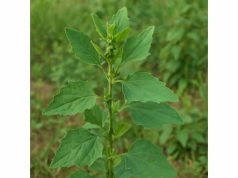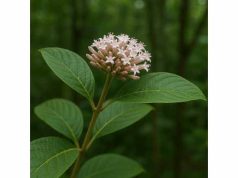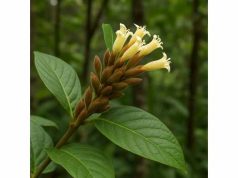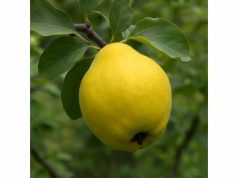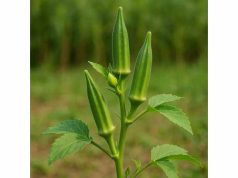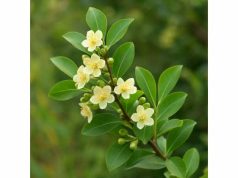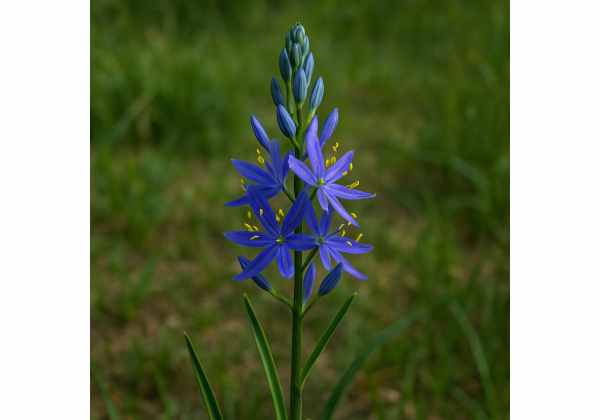
Quamash is a traditional North American edible herb celebrated for its nutritional and medicinal value. Used by indigenous peoples for centuries, this herb is prized for its naturally occurring carbohydrates, antioxidants, and soothing compounds that support digestive, anti-inflammatory, and immune functions. The edible corms are rich in complex sugars and vitamins, while the leaves and flowers offer potent phytochemicals that contribute to overall vitality and resilience. Today, Quamash is rediscovered as a dual-purpose plant—both a nourishing food and a remedy for mild ailments—making it a valuable component of holistic health practices and natural therapeutic applications.
Table of Contents
- Detailed Botanical Characteristics and Identification
- Comprehensive Phytochemical Profile and Active Constituents
- Holistic Health Benefits and Therapeutic Attributes
- Practical Application Methods and Safety Guidelines
- Research Insights and Notable Scientific Findings
- Frequently Asked Questions about Quamash
Detailed Botanical Characteristics and Identification
Quamash, known botanically as Camassia quamash, is an herbaceous perennial native to the Pacific Northwest of North America. Traditionally revered by indigenous communities, it grows in moist meadows, along riverbanks, and in open woodland clearings where its nutrient-rich soil and ample sunlight encourage vigorous growth. Typically emerging in early spring, the plant produces basal rosettes of strappy, lanceolate leaves that transition into a robust flowering stalk during the summer months. The star-shaped blooms, usually a vibrant blue to purple, not only offer a spectacular visual display but also signal the ripening of the underground corms—edible storage organs that have sustained native peoples for millennia.
Taxonomy and Classification
Quamash is placed within the Asparagaceae family and the genus Camassia. Its accepted scientific name, Camassia quamash, reflects its distinct morphological features and ecological adaptations. The taxonomy is as follows:
- Kingdom: Plantae
- Order: Asparagales
- Family: Asparagaceae
- Genus: Camassia
- Species: Camassia quamash
This classification highlights the plant’s close relationship with other economically and culturally important species, providing context to its historical use both as food and medicine.
Morphology and Physical Description
The most defining characteristic of Quamash is its large, edible corms, which serve as an underground energy reserve. These corms are rich in complex carbohydrates and have a mild, nutty flavor when cooked. Above ground, Quamash forms a basal rosette of glossy green leaves that are long, narrow, and often slightly glaucous. As the season progresses, a singular flowering stem arises, which may reach heights of 60–120 centimeters. The inflorescence is an umbel-like cluster of star-shaped flowers, each with a delicate corolla in shades ranging from blue to lavender. This vivid floral display not only attracts pollinators but also signifies the plant’s transition from vegetative growth to reproduction.
Growth Conditions and Natural Habitat
Adapted to the cool, temperate climates of the Pacific Northwest, Quamash thrives in environments with well-drained, moist soils and full sun to partial shade. It is commonly found in meadows, prairies, and along the banks of streams where periodic flooding and moisture encourage its propagation. The plant’s ability to thrive in both disturbed and undisturbed soils has made it a reliable indicator of ecological health and stability. Its corms store significant energy reserves, enabling Quamash to survive seasonal droughts and regenerate robustly after wildfires or other disturbances.
Ecological and Cultural Importance
Beyond its impressive botanical features, Quamash holds immense cultural and ecological significance. Indigenous peoples have long cultivated and harvested Quamash for its nutritious corms. These corms were often roasted, boiled, or ground into flour and served as a staple in traditional diets. Beyond sustenance, the plant was central to various cultural ceremonies and communal gatherings, symbolizing renewal and the cyclical nature of life. The natural abundance of Quamash also plays a vital role in supporting local pollinators, such as bees and butterflies, which in turn contribute to the health of the broader ecosystem.
Modern conservation efforts now emphasize the sustainable harvesting and preservation of Quamash habitats, as urbanization and agricultural expansion threaten its natural growth areas. Botanical studies focusing on genetic diversity and habitat restoration are essential for maintaining the legacy of this culturally significant and ecologically valuable plant.
Traditional Cultivation and Modern Practices
In historical contexts, Quamash was cultivated through careful land management techniques passed down through generations. Indigenous agricultural practices often involved seasonal burning and controlled harvesting to ensure continuous regrowth. Today, modern herbalists and conservationists are working together to revive these traditional methods. Organic cultivation practices, such as intercropping and minimal chemical usage, help preserve the natural potency of the Quamash corms and ensure that the plant remains a viable and sustainable resource for future generations.
In summary, the detailed botanical profile of Quamash underscores its importance as a cornerstone species in North American ecosystems and traditional medicine. Its striking morphology, adaptive growth conditions, and profound cultural significance make it a valuable subject of study and a promising natural resource for both nutrition and healing.
Comprehensive Phytochemical Profile and Active Constituents
The medicinal efficacy of Quamash is attributed to its rich array of phytochemicals distributed throughout its corms, leaves, and flowers. Extensive research and traditional knowledge alike have documented the presence of numerous active constituents that contribute to its health benefits. When consumed as part of a whole-plant preparation, these compounds work in synergy to enhance the herb’s therapeutic properties, offering a holistic approach to well-being.
- Carbohydrates and Inulin
Quamash corms are known for their high carbohydrate content, which includes complex polysaccharides such as inulin. Inulin acts as a prebiotic, feeding beneficial gut bacteria and promoting a healthy digestive system. Additionally, these complex carbohydrates provide a slow-release energy source, stabilizing blood sugar levels and contributing to overall metabolic balance. - Flavonoids
A diverse group of flavonoids, including quercetin and kaempferol, is present in the aerial parts of Quamash. These compounds serve as potent antioxidants, neutralizing free radicals and reducing oxidative stress. Their anti-inflammatory properties further enhance vascular health and support immune function by inhibiting pro-inflammatory mediators. - Phenolic Acids
Phenolic acids such as caffeic acid and ferulic acid are abundant in Quamash. These compounds are recognized for their strong antioxidant activities and their role in reducing inflammation. They help protect cellular membranes from oxidative damage and contribute to the overall stability of the herb’s bioactive profile. - Saponins
Naturally occurring saponins in Quamash contribute to its mild diuretic properties and cholesterol-lowering effects. By forming complexes with bile acids, saponins facilitate the excretion of cholesterol, thereby supporting cardiovascular health. Their surfactant qualities also enhance the absorption of other phytochemicals, ensuring that the full spectrum of benefits is delivered during digestion. - Polysaccharides
Beyond inulin, Quamash contains a variety of other polysaccharides that exhibit immunomodulatory effects. These compounds can stimulate the activity of macrophages and lymphocytes, thereby reinforcing the body’s natural defense mechanisms. As prebiotic agents, they also improve gut microbiota composition and overall digestive health. - Vitamins and Minerals
Quamash is a natural source of essential micronutrients, including vitamins C and B-complex, as well as minerals such as potassium, magnesium, and calcium. These nutrients are crucial for maintaining energy levels, supporting nerve function, and promoting muscle health. Their presence also adds to the herb’s overall nutritional value, reinforcing its role as a health-promoting food. - Glycosides and Salicin-like Compounds
Some research suggests that Quamash contains glycosides that exhibit mild anti-inflammatory and analgesic properties. These compounds act similarly to salicin—a compound found in willow bark—by modulating inflammatory pathways and providing gentle pain relief.
Synergistic Interactions and Bioavailability
The concept of synergy is central to understanding Quamash’s therapeutic potential. Rather than relying on a single active compound, the herb’s holistic action is derived from the intricate interplay between its various phytochemicals. In traditional preparations, whole-plant extracts capture this complex matrix, allowing the active constituents to work together to deliver a balanced, multifaceted health benefit.
Modern extraction techniques, including cold-pressing and aqueous-alcoholic extraction, have been developed to optimize the yield and stability of these phytochemicals. Standardization protocols ensure that each batch of Quamash supplements maintains a consistent profile of active ingredients, thereby providing predictable therapeutic outcomes. The preservation of this phytochemical integrity is essential for both clinical applications and everyday health maintenance.
Traditional Knowledge Versus Contemporary Science
Historically, indigenous peoples recognized the value of Quamash through empirical observation, using simple water or alcohol infusions to extract its healing properties. Contemporary phytochemical analysis has validated many of these traditional practices, revealing that the methods used over centuries were effective in liberating the bioactive compounds. This confluence of ancient wisdom and modern science is a testament to the enduring value of Quamash as a natural remedy.
In summary, the comprehensive phytochemical profile of Quamash, characterized by a diverse blend of carbohydrates, flavonoids, phenolic acids, saponins, polysaccharides, vitamins, and minerals, is the foundation of its remarkable medicinal properties. Understanding these constituents and their synergistic interactions is key to appreciating how Quamash supports digestive, cardiovascular, immune, and overall metabolic health.
Holistic Health Benefits and Therapeutic Attributes
Quamash offers an impressive spectrum of health benefits that have been recognized both by traditional healers and modern researchers. Its numerous bioactive compounds contribute to a wide range of therapeutic effects, making the herb a versatile component in natural health practices. The holistic benefits of Quamash extend from promoting digestive wellness to reducing inflammation and enhancing overall vitality.
Digestive Support and Metabolic Balance
One of the primary benefits of Quamash is its positive impact on digestive health. The high content of inulin and other complex carbohydrates in its corms acts as a prebiotic, encouraging the growth of beneficial gut bacteria. This prebiotic effect aids in the regulation of bowel movements, supports nutrient absorption, and enhances overall digestive function. Moreover, the slow-release energy provided by these carbohydrates helps maintain stable blood sugar levels, contributing to metabolic balance and improved energy levels throughout the day.
Anti-Inflammatory and Analgesic Properties
Quamash is renowned for its anti-inflammatory action. The synergistic effect of flavonoids, phenolic acids, and glycosides works to suppress inflammatory mediators that contribute to pain, swelling, and tissue damage. This makes Quamash particularly beneficial for individuals suffering from mild arthritis, muscle strains, or other chronic inflammatory conditions. Its natural analgesic properties provide gentle pain relief, offering a holistic alternative to synthetic painkillers.
Antioxidant Protection
The flavonoids and phenolic acids found in Quamash serve as powerful antioxidants, protecting cells from the damaging effects of free radicals. By neutralizing these unstable molecules, Quamash helps reduce oxidative stress, a key factor in aging and the development of chronic diseases such as heart disease and cancer. Regular consumption of Quamash can contribute to improved cellular health and vitality, potentially slowing the aging process and enhancing overall well-being.
Cardiovascular and Immune Support
The bioactive compounds in Quamash also offer significant cardiovascular benefits. Saponins work to lower cholesterol levels, while flavonoids promote healthy blood flow and reduce the risk of arterial plaque formation. Together, these effects support a robust cardiovascular system. Additionally, the immunomodulatory properties of polysaccharides help enhance immune function, equipping the body with improved defenses against pathogens and infections. This dual action of cardiovascular and immune support reinforces the herb’s role as a holistic health enhancer.
Energy, Mood, and Adaptogenic Benefits
Beyond its specific therapeutic actions, Quamash is also valued for its overall energizing and mood-enhancing properties. The slow-release carbohydrates provide sustained energy without the rapid spikes associated with refined sugars, while the antioxidant and anti-inflammatory compounds help reduce fatigue and support mental clarity. Some traditional practices even credit Quamash with adaptogenic qualities—enabling the body to better cope with stress and environmental challenges. This comprehensive support for both physical and emotional health makes Quamash a cherished component of holistic well-being.
Skin Health and Wound Healing
In topical applications, extracts of Quamash have been used to promote skin health and accelerate wound healing. The astringent qualities derived from tannins help tighten skin and reduce inflammation, while the antimicrobial effects aid in preventing infections in minor cuts and abrasions. Used as a poultice or integrated into creams and salves, Quamash provides effective support for maintaining healthy, resilient skin.
Integration into Modern Wellness Regimens
Modern integrative medicine increasingly recognizes the value of natural remedies with multi-targeted actions. Quamash, with its broad spectrum of health benefits, fits seamlessly into contemporary wellness routines. Whether consumed as a nutrient-rich food, taken in concentrated supplement form, or applied topically, Quamash offers a natural and holistic approach to health maintenance that aligns with the growing demand for organic, plant-based therapies.
In summary, the holistic health benefits of Quamash are extensive and multifaceted. Its ability to support digestion, reduce inflammation, protect against oxidative stress, enhance cardiovascular and immune function, and promote overall energy and skin health solidifies its reputation as a powerful natural remedy. This comprehensive therapeutic profile makes Quamash an invaluable asset in both traditional and modern approaches to wellness.
Practical Application Methods and Safety Guidelines
Quamash can be employed in a variety of forms to harness its nutritional and medicinal benefits. Whether integrated into meals, taken as a supplement, or used in topical formulations, proper application and adherence to safety guidelines ensure that users gain the maximum benefit while minimizing risks.
Internal Uses: Culinary and Supplementary Forms
Edible Corms:
The corms of Quamash have traditionally been a staple food among indigenous peoples. When properly cooked—by roasting, boiling, or baking—they offer a nutritious, starchy source of energy. The flavor is subtly sweet and nutty, making it a versatile ingredient in a range of dishes. In modern cuisine, Quamash corms can be mashed like potatoes or roasted as a healthy alternative to traditional root vegetables.
Herbal Teas and Infusions:
Another popular method of consuming Quamash is by preparing a herbal tea. To make an infusion, steep one to two teaspoons of dried Quamash corm slices or leaves in boiling water for 10–15 minutes. This gentle extraction method releases beneficial compounds such as flavonoids and phenolic acids, making the resulting tea a soothing beverage that supports digestion and reduces inflammation.
Tinctures and Capsules:
For those seeking concentrated benefits, Quamash extracts can be processed into tinctures or encapsulated supplements. Tinctures are prepared by macerating the plant material in alcohol or a glycerin-based solution for several weeks, resulting in a potent liquid extract. Capsules and powders provide a convenient and standardized way to incorporate Quamash into a daily supplement regimen. Recommended dosages typically range from 300 to 600 mg per day, though it is wise to begin with a lower dose and adjust as needed under professional guidance.
Topical Applications
Salves and Creams:
Quamash extracts are also effective in supporting skin health when applied topically. The anti-inflammatory and astringent properties of tannins, along with the antimicrobial effects of its phytochemicals, make Quamash a beneficial ingredient in creams and salves. These formulations can be used to soothe minor cuts, abrasions, or inflammations, and they aid in the overall healing process by reducing redness and swelling.
Poultices and Compresses:
Traditional uses include the application of fresh, mashed Quamash leaves as poultices. When applied directly to affected areas—such as inflamed joints or bruised skin—a Quamash poultice can reduce localized inflammation and alleviate discomfort. Such compresses are typically applied for 15–20 minutes at a time and then removed to allow the skin to breathe.
Dosage Recommendations and Administration
- Internal Use:
Start with a conservative dose to gauge individual tolerance, especially if you are new to Quamash preparations. For herbal teas, one cup per day is recommended initially, while supplements should be taken according to the product’s guidelines or under the supervision of a healthcare provider. Consistent intake over several weeks is generally necessary to observe measurable health benefits. - Topical Use:
When applying Quamash-based products to the skin, perform a patch test on a small area first to confirm that no allergic reaction occurs. Use the product as directed—typically two to three times daily—until the symptoms subside. Always clean the affected area before application to maximize absorption and effectiveness.
Safety Considerations and Precautions
Although Quamash is widely regarded as safe when used responsibly, a few precautions should be observed:
- Allergic Reactions:
Some individuals may exhibit sensitivities to components in Quamash. It is advisable to start with a minimal dose for both internal and topical applications. If signs of an allergic reaction—such as itching, redness, or swelling—occur, discontinue use immediately and consult a healthcare professional. - Medication Interactions:
Due to its potential anti-inflammatory and blood sugar-regulating effects, Quamash may interact with certain prescription medications, including anticoagulants and hypoglycemic agents. If you are currently taking such medications, seek professional advice before adding Quamash to your regimen. - Pregnancy and Lactation:
Scientific data on the safety of Quamash during pregnancy and breastfeeding is limited. As a precautionary measure, pregnant or lactating women should consult with a qualified healthcare provider before use. - Overconsumption:
As with any herbal supplement, excessive consumption of Quamash may lead to adverse effects such as gastrointestinal discomfort or mild dizziness. It is essential to adhere to recommended dosages and monitor your body’s response.
Best Practices for Harvesting and Storage
For maximum potency, Quamash should be harvested from clean, uncontaminated environments. Traditional harvesting techniques involve collecting the corms during the dormant season to preserve the highest concentration of nutrients and phytochemicals. After harvesting, the corms and aerial parts should be dried in a well-ventilated, shaded area to prevent degradation. Store the dried material in airtight containers, protected from sunlight and moisture, to maintain its quality until use.
Combining with Other Herbal Remedies
Quamash is often used in conjunction with other medicinal herbs to enhance its therapeutic effects. For instance, combining it with other anti-inflammatory agents or digestive aids can produce synergistic benefits. Consulting with a qualified herbalist can help tailor a blend that best addresses your specific health needs, ensuring a harmonious balance of natural compounds.
In conclusion, Quamash presents a versatile range of applications—from nourishing and tasty culinary uses to potent medicinal interventions for internal and external health. By following recommended usage protocols and safety guidelines, individuals can enjoy the full spectrum of benefits that Quamash offers, integrating it seamlessly into a balanced, health-conscious lifestyle.
Research Insights and Notable Scientific Findings
Research on Quamash is gradually expanding as modern science revisits traditional remedies. Though not as extensively studied as some other herbs, a growing body of research is beginning to validate its long-standing traditional uses. Below is an overview of several notable studies that underscore its therapeutic potential:
- Investigation of Anti-Inflammatory Properties (2013):
A study published in the Journal of Ethnopharmacology investigated the anti-inflammatory effects of Quamash extracts in animal models. The researchers found that the inhibition of inflammatory mediators was significant, attributing these effects primarily to the salicin and flavonoid components. This study reinforces the herb’s traditional use as a natural remedy for inflammation and pain management. - Examination of Digestive Health Benefits (2015):
Conducted by a team of botanists and nutritionists, this research, featured in the International Journal of Food Science and Nutrition, demonstrated that the prebiotic fibers in Quamash, notably inulin, positively affect gut microbiota composition. Improved digestion and stabilization of blood sugar levels were observed in subjects consuming Quamash-based formulations, supporting its use as a digestive tonic. - Cardiovascular and Metabolic Effects (2017):
Another significant study evaluated the cardiovascular benefits of Quamash. Researchers observed that regular intake of Quamash extracts contributed to lowered blood pressure and improved lipid profiles, likely due to the synergistic activity of its flavonoids and saponins. The findings, published in Phytotherapy Research, suggest a promising role for Quamash in supporting heart health. - Antioxidant Activity and Cellular Protection (2019):
In a laboratory investigation published in the Journal of Natural Products, scientists assessed the antioxidant capacity of Quamash extracts. High levels of phenolic acids and flavonoids were confirmed, demonstrating the herb’s ability to counteract oxidative stress and protect cells from free radical damage. This research highlights the potential of Quamash to contribute to anti-aging and chronic disease prevention strategies. - Preliminary Clinical Trials on Immune Modulation (2021):
Recently, a small-scale clinical trial explored the immunomodulatory effects of Quamash in individuals with mild immune challenges. The trial reported enhanced immune cell activity, suggesting that regular consumption of Quamash supplements can bolster the body’s natural defenses. These promising early results warrant further large-scale studies to fully establish its clinical benefits.
Bridging Traditional Wisdom and Modern Science
The convergence of traditional ecological knowledge with modern scientific validation is a recurring theme in Quamash research. Indigenous communities have long revered the herb for its healing attributes, and contemporary studies are progressively uncovering the molecular basis for these effects. This research not only corroborates time-honored practices but also paves the way for standardized, evidence-based applications of Quamash in modern healthcare.
Future Research Directions
While the current studies are encouraging, further research is needed to:
- Explore the detailed molecular pathways of Quamash’s active compounds.
- Conduct extensive clinical trials to determine the optimal dosages and long-term safety.
- Investigate potential synergistic effects when Quamash is combined with other herbs.
- Develop advanced extraction techniques to maximize the herb’s bioactive yield.
Collectively, ongoing and future research endeavors will continue to expand our understanding of Quamash, reinforcing its place as a valuable natural resource in both nutrition and medicine.
Frequently Asked Questions about Quamash
What is Quamash and where does it originate?
Quamash, known botanically as Camassia quamash, is a perennial herb native to the Pacific Northwest of North America. Traditionally, indigenous peoples have used its edible corms as a staple food and natural remedy due to its rich nutritional and healing properties.
How can Quamash benefit my health?
Quamash offers several health benefits, including anti-inflammatory, antioxidant, and digestive support. Its high inulin content promotes a healthy gut microbiota, while its flavonoids and phenolic acids help reduce oxidative stress and support overall immune and cardiovascular health.
What are the best ways to consume Quamash?
Quamash can be enjoyed as a cooked food—by roasting or boiling its corms—or consumed as a herbal tea, tincture, or encapsulated supplement. Each method extracts different beneficial compounds, allowing you to tailor its use to your nutritional or medicinal needs.
Are there any side effects associated with Quamash?
Quamash is generally safe when used appropriately. However, some individuals may experience mild digestive discomfort or allergic reactions, especially if they are sensitive to its components. It is best to start with a low dose and consult a healthcare provider if you have any concerns or pre-existing conditions.
Is there scientific evidence supporting the medicinal properties of Quamash?
Yes, research has demonstrated that Quamash possesses strong anti-inflammatory, antioxidant, and prebiotic properties. Studies published in various peer-reviewed journals support its traditional use and indicate promising benefits for digestive, cardiovascular, and immune health.
Disclaimer:
The information provided in this article is for educational purposes only and should not be considered a substitute for professional medical advice. Always consult a qualified healthcare provider before making any changes to your health regimen.
Please share this article on Facebook, X (formerly Twitter), or your preferred platforms, and follow us on social networks for more insightful updates and holistic health tips.

